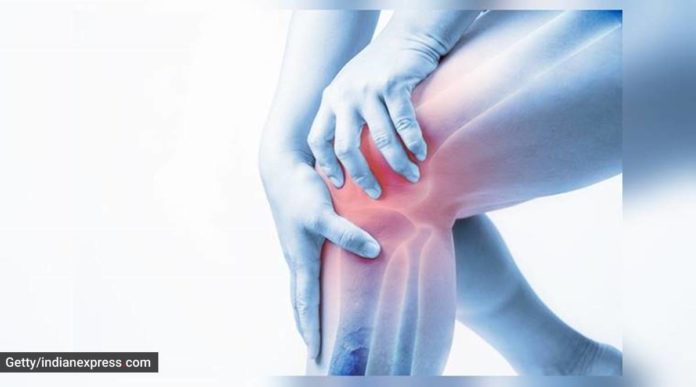Joint pain is a type of distress that can occur in any joint. Arthralgia is the medical term for joint pain. This is distinct from arthritis, which is defined as joint inflammation characterised by pain, warmth, redness, and/or swelling of the joint. A joint can be painful even if it isn’t inflamed, or it can be painful and inflamed at the same time.
It could begin with a minor pain in your hip or a snag in your knee. Then you notice that movements you used to take for granted — like climbing stairs, going for a long walk, or crouching down to pick something up — turn that pang into a persistent ache. You’ll soon find yourself avoiding those activities. Osteoarthritis is almost certainly to blame. This is the most prevalent type of arthritis, and it occurs as a result of joint wear and strain. It could also be the result of a long-ago injury that has reappeared 20 or 30 years later. It may run in the family for certain people.
Osteoarthritis is a condition in which the smooth covering on the ends of your bones, known as cartilage, wears away. Cartilage makes it possible for your joints to move freely and painlessly. The bones begin to rub together as the cartilage thins, creating irritation and pain. Also read our blog on diabetes.
Here are things you need to know about finding relief:
1. Maintain a healthy weight.
Your joints are put under more strain and pressure when you gain weight. Even small weight loss might make a major difference in the amount of pain you feel. The smartest thing anyone could do for the your joints is maintain a healthy weight range. Weight-bearing joints, such as your knees, hips, and back, must sustain a portion, if not the entirety, of your body weight. This is why so many obese people have issues with these body parts.
2. Stay active.
When it comes to joints, mobility is the cream that keeps them lubricated. Choose low-impact activities such as riding, walking, and swimming instead of jogging or tennis. Pool workout is a fantastic option since it provides buoyancy, which relieves joint tension while the water’s resistance improves strength. Don’t just sit there! Couch potatoes, internet addicts, and anyone who spends their days tied to a chair are at a significant risk of developing joint pain. More rigidity in your joints equals less movement.
3. Take advantage of medications and injections.
Pain can be managed with over-the-counter medications such as acetaminophen, ibuprofen, and naproxen. Your health care practitioner can also offer a number of medication anti-inflammatory drugs. Injections of steroid medication into your joint can help to lessen inflammation and pain. Gel shots lubricate the motion, making it more fluid.
4. Consider replacement surgery.
As osteoarthritis advances, medicines and injections typically become less effective. It’s the time to consult with your doctor and a surgeon about replacing the joint. While joint replacement and rehabilitation are still invasive and time-consuming, they have progressed to the point where you can return to your favourite activities in just a few months.
5. Don’t keep putting it off.
While almost any knee or hip can be repaired, it can be difficult to regain full range of motion when a knee becomes severely rigid. Additionally, as the cartilage wears down, the bones continue to scrape against each other, resulting in bone loss. Osteoarthritis treatment is important about preserving your desired quality of life. If you can do it without surgery, that’s fantastic. If you are a fit for surgical intervention, however, you can schedule your procedure whenever you like.
6. Quit smoking.
Smoking promotes connective tissue tension, which can exacerbate discomfort.
7. Use good posture.
You can learn how to sit, stand, and move properly with the help of a physical therapist. Slouching is bad for your knees and hips. From your neck to your knees, standing and sitting up properly preserves your joints. In addition, strong core protects your hip joints and back muscles. When lifting and hauling, posture is also crucial. If you’re wearing a backpack, for example, make sure it’s slung over both shoulders rather than just one. Your joints are put under extra strain if you’re lopsided. Instead of bending your back when lifting, engage the largest muscles in the body by bending at the knees.
8. Know your limits.
Maintain a healthy balance of activity and rest, and avoid overdoing it. In addition, modifying one’s lifestyle is critical for pain relief. Certain exercises and activities may be too demanding for your joints at initially. Slow down. Exercises that cause joint pain should be modified. Make changes with the help of a coach, chiropractor, or guide. After a few days of working out, you may most certainly experience muscle ache, especially on the second and third days. Listen to your body and understand the difference between “danger pain” and “muscle-building pain.”
9. Eating Right Nourishes Joints
A nutritious diet is beneficial to your joints since it aids in the development of strong bones and muscles. Make sure you obtain adequate calcium every day for your bones. Milk, yoghurt, broccoli, kale, figs, and fortified foods like soy or almond milk can help you do this. If such meals don’t entice you, talk to your doctor about whether calcium supplements are good for you.
You must consume enough protein to maintain your muscles. The amount you require is determined on your age, gender, and level of activity. The majority of Americans consume enough protein. Lean meats, shellfish, beans, legumes, soy products, and nuts are all good sources.




